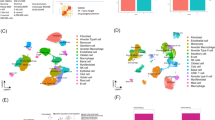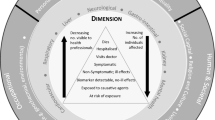Abstract
Background
Coal dust particles (CDP), an inevitable by-product of coal mining for the environment, mainly causes coal workers’ pneumoconiosis (CWP). Long-term exposure to coal dust leads to a complex alternation of biological processes during regeneration and repair in the healing lung. However, the cellular and complete molecular changes associated with pulmonary homeostasis caused by respiratory coal dust particles remain unclear.
Methods
This study mainly investigated the pulmonary toxicity of respirable-sized CDP in mice using unbiased single-cell RNA sequencing. CDP (< 5 μm) collected from the coal mine was analyzed by Scanning Electron Microscope (SEM) and Mass Spectrometer. In addition, western blotting, Elisa, QPCR was used to detect gene expression at mRNA or protein levels. Pathological analysis including HE staining, Masson staining, immunohistochemistry, and immunofluorescence staining were performed to characterize the structure and functional alternation in the pneumoconiosis mouse and verify the reliability of single-cell sequencing results.
Results
SEM image and Mass Spectrometer analysis showed that coal dust particles generated during coal mine production have been crushed and screened with a diameter of less than 5 µm and contained less than 10% silica. Alveolar structure and pulmonary microenvironment were destroyed, inflammatory and death (apoptosis, autophagy, and necrosis) pathways were activated, leading to pneumoconiosis in post 9 months coal dust stimulation. A distinct abnormally increased alveolar type 2 epithelial cell (AT2) were classified with a highly active state but reduced the antimicrobial-related protein expression of LYZ and Chia1 after CDP exposure. Beclin1, LC3B, LAMP2, TGF-ß, and MLPH were up-regulated induced by CDP, promoting autophagy and pulmonary fibrosis. A new subset of macrophages with M2-type polarization double expressed MLPH + /CD206 + was found in mice having pneumoconiosis but markedly decreased after the Vitamin D treatment. Activated MLPH + /CD206 + M2 macrophages secreted TGF-β1 and are sensitive to Vitamin D treatment.
Conclusions
This is the first study to reconstruct the pathologic progression and transcriptome pattern of coal pneumoconiosis in mice. Coal dust had obvious toxic effects on lung epithelial cells and macrophages and eventually induced pulmonary fibrosis. CDP-induced M2-type macrophages could be inhibited by VD, which may be related to the alleviation of the pulmonary fibrosis process.
Similar content being viewed by others
Introduction
Coal remains the primary source of electricity (60%) and iron production (40%) globally [1]. Coal dust hazards in coal mining have been studied continuously by the WHO (World Health Organization) and governments of many countries. As of 2018, pneumoconiosis accounted for 90% of occupational diseases reported in China's occupational health status reports, with 200 million people still at risk of occupational health exposure [2]. The rates of pneumoconiosis in Australia have started rising [3]. Many studies have clearly shown that coal particles have cytotoxicity, pro-inflammatory, pro-fibrotic properties, and a complex progress mechanism [4,5,6]. The most extensive study on pneumoconiosis in the U.S. revealed that respirable dust from coal miners caused progressive massive fibrosis (PMF) even after dust exposure has ceased [7, 8]. Mine Safety and Health Administration (MSHA) issued new regulations [9] for respirable coal dust concentration limit (from 2.0 to 1.5 mg/ m3). However, the prevalence rate continued to increase, with some regions such as the central Appalachian area seeing a sixfold increase [10]. There is no effective treatment for coal workers' pneumoconiosis.
Continued exposure to high concentrations of coal dust may lead to an inability to remove accumulated dust particles, resulting in structural damage to the alveoli [11]. Alveolar epithelial cells are the primary functional unit for O2 exchange and the first point of contact for inhaled particles [11]. Successful alveolar epithelial repair and functional recovery require the proliferation and differentiation of alveolar type 2 stem/progenitor cells (AT2). During the regeneration process, alveolar epithelial cells have been reported to have dysplasia or developmental delays in repair [12], which is associated with many chronic lung diseases [13]. Commonly, inflammatory monocytes and pulmonary macrophages are the keys to lung repair and fibrosis regulators. Lung macrophages in healthy adults are divided into mononuclear mesenchymal macrophages and tissue-resident macrophages that develop from embryonic precursors. Abnormal tissue niches can lead to the development of abnormally differentiated tissue-resident macrophages [14]. Alveolar macrophages (AMs), the central target cells of coal dust during phagocytosis and clearance, are related to oxidative stress and the activation of the innate immune system [15]. Exogenous pathways regulate apoptosis and the release of fibrotic factors from AMs. TNF-α, IL 6, and IL 1β are recognized pro-inflammatory factors released by macrophages [Full size image
To further predict the toxic damage mechanism in CMP lungs, we studied the signaling correspondence between epithelia and macrophages. After coal dust treatment, these cells co-located in space and actively signaled to each other. There were significant positive and negative signal states in macrophages, indicating that the cell state transition under coal dust exposure was highly regulated. Specifically, the TNF pathway showed rich signaling interactions among all four states, with CD74 receptors expressed primarily by macrophages. In addition, the dominantly ligand CD44 was contributing to dermal TGF signaling, which promotes granuloma formation by stimulating the in situ proliferation of mononuclear cells through autocrine and paracrine signaling [52]. Furthermore, macrophages secreted SPP1 to multiple cell surface receptors, consistent with the known role of physiological and pathological processes, including wound healing, inflammation, tumorigenesis, and ischemia. In addition, epithelial cells were the major ligand source for another important Notch signaling pathway that primarily expresses autocrine Notch1 and Notch2 in CMP.
The Cell Phone DB analysis also predicted that this dominant macrophage notch signaling was supplemented by a minor epithelial-derived Nothch2 ligand paracrine signaling, promoting macrophage M2 polarization, dependent on the interaction with CD47 and mediated by intracellular signaling through SHP-1 [53, 54]. Our analysis showed solid intercellular communication between macrophages and epithelial cells, including the innate immune system signaling members SIRPA and CD47, and Notch signaling ligands Jag1, gag2, Tgfb2, and Fam3c (Fig. 7D). These results further emphasize the indispensable roles of these well-defined pathways during coal dust lung specification. In addition, we observed robust ligand-receptor pairs within the epithelial cells and macrophage population, including SSP1, TGF-b, and CD74, indicating a robust autocrine relationship at this stage (Fig. 7C). However, some of these ligand-receptor pairs differed between epithelial cells and macrophages, suggesting heterogeneity in coal dust lung cells, as illustrated in our DEG analysis.
The infiltrated M2-type alveolar macrophages with CD206+ and MLPH+ subset after the long-term coal exposure were significantly decreased after Vitamin D treatment
Next, we focused on markers of specialized biological features of macrophages. Using scRNA-Seq, the marker gene expression of macrophage clusters was shown in Additional file 4: Fig. S4 and Additional file 8: Table S7. The specialized M2 phenotypes expressing MLPH markers were found, further illustrating the specific M2 subset (Fig. 8B). Finally, alveolar macrophages in CMP lungs were polarized into the M2-type subset (Fig. 8A), and a fraction of this population was identified with double CD206+MLPH+ expression in vivo and in vitro. In addition, the scRNA-Seq showed that 9-month coal-dust exposed lung tissues had increased M2 cells and relatively decreased M1 cells compared to control groups; however, this trend was reversed in the VD3-treated group (Fig. 8C).
A distinctive M2 type activation in alveolar macrophages after coal exposure A A single-cell sequencing plot shows the effects of coal exposure and Vitamin D supplemented coal exposure on the polarization of macrophages to the M2-type. B The group’s distribution of canonical cell markers CD86, Mrc1, and MLPH target gene transcripts across the t-distributed stochastic neighbor embedding (tSNE) plot. The subset of M1 cells was identified by CD86 expression, and the M2 subset was identified by Mrc1 expression. The color key indicates MAGIC-imputed gene expression values. C Violin plots display the distribution of the expression of previously reported M2 polarization-related markers (Mrc1, up), M1 polarization-related markers CD86, bottom). D Double immunofluorescence staining of MLPH and CD206 verified M2-type macrophages that emerged after coal exposure and disappeared after the Vitamin D treatment in the lung tissue and Raw267.4 cells both in vivo and in vitro. Scale bar, 40 μm. E The RAW264.7 cells were treated with phosphate-buffered saline (PBS; control), coal dust, and a combination of coal dust and Vitamin D; the whole-cell lysates were harvested 24 h after the treatment. Western blots determined the expression level of MLPH. β-actin was used as the internal control
Here, we focused on CD86, Mrc1, and MLPH for two reasons. First, CD68 and Mrc1 represent two different identities of the classical macrophage classification of M1 and M2 [55]. Second, scRNA-Seq data suggested that the MLPH expression was explicitly increased in alveolar macrophages at 9-month CMP, but only increased in M2 cells. Using selective marker genes (CD86 for M1 and Mrc1 for M2), we were able to confirm the predicted emergence of MLPH+ macrophages and upregulated in M2 cells only in CWP lungs (Fig. 8B). Vitamin D exerts its beneficial effects on many macrophage components, modulating phagocytic activity and cytokine production [56]. To validate that VD3 accurately regulated gene expression in specific macrophage populations, we performed in situ immunofluorescent staining (Fig. 8D) and western blot (Fig. 8E, F) of the samples from the same tissues used for single-cell RNA-Seq analysis. The result showed that the MLPH expressed in CMP lungs increased significantly more than in the control lungs but markedly decreased after the Vitamin D treatment. Furthermore, the qPCR and ELISA analysis revealed that coal-exposed macrophages had increased TGF-β expression and secretion but decreased after the VD3 treatment (Fig. 8G, H). TGF-β plays a critical role in lung inflammation and is a recognized indicator of fibrosis. Our results suggest that VD3 may be a potential alternative treatment for alleviating pulmonary fibrosis caused by coal dust. These results also support the feasibility of the supplement of the VD3 in patients with coal pneumoconiosis.





